Brother Sewing Machines User Manual
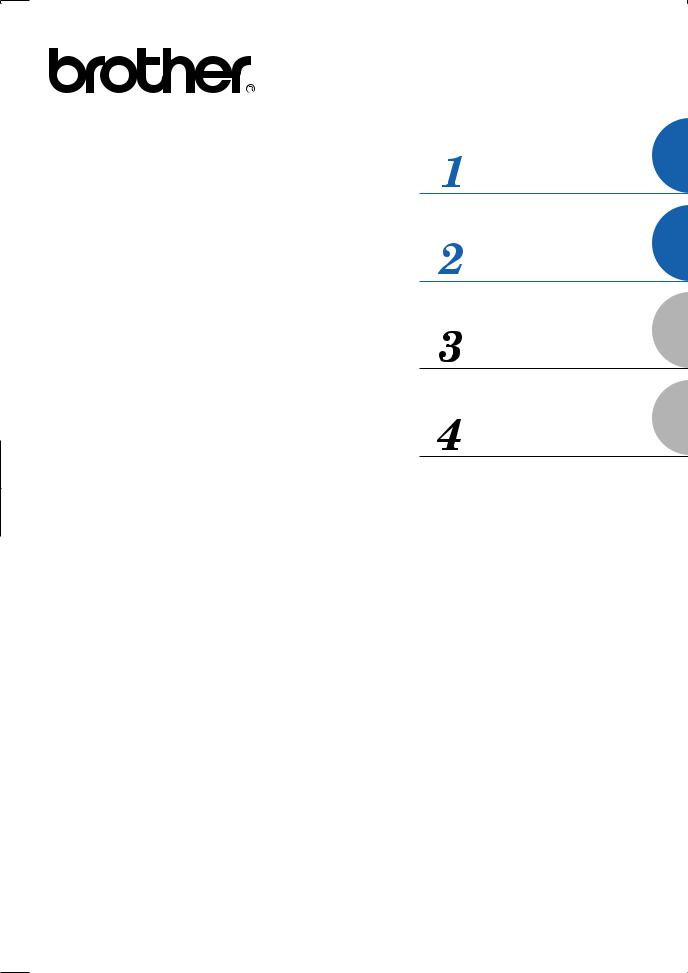
GETTING READY
SEWING BASICS
UTILITY STITCHES
APPENDIX
Operation Manual
Computerized Sewing Machine

————————————————————————————————————————————————————
Important Safety Instructions
Please read these safety instructions before attempting to use the machine. This machine is intended for household use.
DANGER - To reduce the risk of electric shock:
1Always unplug the machine from the electrical outlet immediately after using, when cleaning, when making any user servicing adjustments mentioned in this manual, or if you are leaving the machine unattended.
WARNING - To reduce the risk of burns, fire, electric shock, or injury to persons.
2Always unplug the machine from the electrical outlet when removing covers, lubricating, or when making any adjustments mentioned in the instruction manual:
•To unplug the machine, switch the machine to the symbol “O” position to turn it off, then grasp the plug and pull it out of the electrical outlet. Do not pull on the cord.
•Plug the machine directly into the electrical outlet. Do not use an extension cord.
•Always unplug your machine if the power is cut.
3 Never operate this machine if it has a damaged cord or plug, if it is not working properly, if it has been dropped or damaged, or water is spilled on the unit. Return the machine to the nearest authorized dealer or service center for examination, repair, electrical or mechanical adjustment. While the machine is stored or in use if you notice anything unusual, such an odor, heat, discoloration or deformation, stop using the machine and immediately unplug the power cord. When transporting the sewing machine, be sure to carry it by its handle. Lifting the sewing machine by any other part may damage the machine or result in the machine falling, which could cause injuries.
When lifting the sewing machine, be careful not to make any sudden or careless movements, otherwise you may injure your back or knees.
1

———————————————————————————————————————————————————
4 Always keep your work area clear:
•Never operate the machine with any air openings blocked. Keep ventilation openings of the sewing machine and foot control free from the build up of lint, dust, and loose cloth.
•Do not store objects on the foot controller.
•Do not use extension cords. Plug the machine directly into the electrical outlet.
•Never drop or insert any object into any opening.
•Do not operate where aerosol (spray) products are being used or where oxygen is being administered.
•Do not use the machine near a heat source, such as a stove or iron; otherwise, the machine, power cord or garment being sewn may ignite, resulting in fire or an electric shock.
•Do not place this sewing machine on an unstable surface, such as an unsteady or slanted table, otherwise the sewing machine may fall, resulting in injuries.
5 Special care is required when sewing:
•Always pay close attention to the needle. Do not use bent or damaged needles.
•Keep fingers away from all moving parts. Special care is required around the machine needle.
•Switch the sewing machine to the symbol “O” position to turn it off when making any adjustments in the needle area.
•Do not use a damaged or incorrect needle plate, as it could cause the needle to break.
•Do not push or pull the fabric when sewing, and follow careful instruction when freehand stitching so that you do not deflect the needle and cause it to break.
6 This machine is not a toy:
•Your close attention is necessary when the machine is used by or near children.
•The plastic bag that this sewing machine was supplied in should be kept out of the reach of children or disposed of. Never allow children to play with the bag due to the danger of suffocation.
•Do not use outdoors.
7 For a longer service life:
•When storing this machine, avoid direct sunlight and high humidity locations. Do not use or store the machine near a space heater, iron, halogen lamp, or other hot objects.
•Use only neutral soaps or detergents to clean the case. Benzene, thinner, and scouring powders can damage the case and machine, and should never be used.
•Always consult the operation manual when replacing or installing any assemblies, the presser feet, needle, or other parts to assure correct installation.
2

————————————————————————————————————————————————————
8 For repair or adjustment:
•If the Light unit (light-emitting diode) is damaged, it must be replaced by authorized dealer.
•In the event a malfunction occurs or adjustment is required, first follow the troubleshooting table in the back of the operation manual to inspect and adjust the machine yourself. If the problem persists, please consult your local authorized Brother dealer.
Use this machine only for its intended use as described in this manual.
Use accessories recommended by the manufacturer as contained in this manual. Save these instructions.
The contents of this manual and specifications of this product are subject to change without notice. For additional product information, visit our web site at www.brother.com
3

———————————————————————————————————————————————————
FOR USERS IN THE UK, EIRE, MALTA AND CYPRUS ONLY
IMPORTANT
•In the event of replacing the plug fuse, use a fuse approved by ASTA to BS 1362, i.e. carrying the
 mark, rating as marked on plug.
mark, rating as marked on plug.
•Always replace the fuse cover. Never use plugs with the fuse cover omitted.
•If the available electrical outlet is not suitable for the plug supplied with this equipment, you should contact your authorized dealer to obtain the correct lead.
FOR USERS IN AUSTRALIA AND NEW ZEALAND
This sewing machine is not intended to be used by young children, and assistance may be required if used by a person with a disability.
4
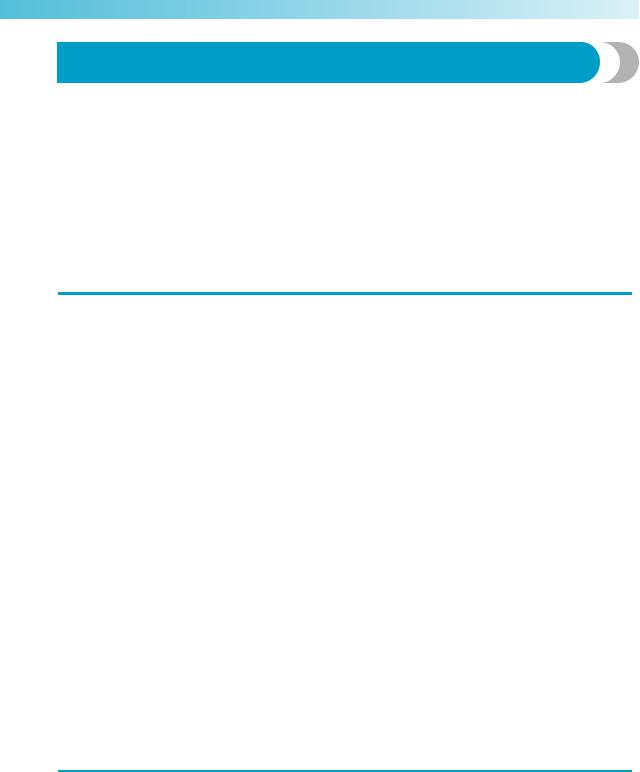
————————————————————————————————————————————————————
Contents |
|
Important Safety Instructions .............................................................................................. |
1 |
Introduction ........................................................................................................................ |
8 |
Sewing Machine Features .................................................................................................... |
8 |
Accessories.......................................................................................................................... |
9 |
Included accessories ......................................................................................................................................... |
9 |
Optional accessories ....................................................................................................................................... |
10 |
Names of Machine Parts and Their Functions ................................................................... |
11 |
Machine.......................................................................................................................................................... |
11 |
Needle and presser foot section ...................................................................................................................... |
12 |
Operation buttons ........................................................................................................................................... |
12 |
Operation panel.............................................................................................................................................. |
13 |
GETTING READY |
15 |
Turning the Machine On/Off............................................................................................. |
16 |
Power supply precautions ............................................................................................................................... |
16 |
Turning on the machine .................................................................................................................................. |
17 |
Turning off the machine .................................................................................................................................. |
17 |
Understanding the LCD Screens........................................................................................ |
18 |
Changing the Machine Settings ......................................................................................... |
19 |
Changing the settings ...................................................................................................................................... |
19 |
Adjusting the brightness of the LCD ................................................................................................................ |
21 |
Winding/Installing the Bobbin........................................................................................... |
22 |
Bobbin precautions ......................................................................................................................................... |
22 |
Winding the bobbin ........................................................................................................................................ |
22 |
Installing the bobbin ....................................................................................................................................... |
26 |
Upper Threading ............................................................................................................... |
28 |
Threading the upper thread ............................................................................................................................. |
28 |
Threading the needle ...................................................................................................................................... |
31 |
Threading the needle manually (without using the needle threader) ................................................................ |
33 |
Using the twin needle ..................................................................................................................................... |
33 |
Pulling up the bobbin thread........................................................................................................................... |
36 |
Replacing the Needle ........................................................................................................ |
37 |
Needle precautions ......................................................................................................................................... |
37 |
Needle types and their uses............................................................................................................................. |
38 |
Checking the needle ....................................................................................................................................... |
39 |
Replacing the needle....................................................................................................................................... |
39 |
Replacing the Presser Foot ................................................................................................ |
41 |
Presser foot precautions .................................................................................................................................. |
41 |
Replacing the presser foot ............................................................................................................................... |
41 |
Removing the presser foot holder .................................................................................................................... |
43 |
Using the optional walking foot ...................................................................................................................... |
44 |
Sewing Cylindrical or Large Pieces.................................................................................... |
46 |
Stitching cylindrical pieces.............................................................................................................................. |
46 |
Sewing large pieces of fabric........................................................................................................................... |
46 |
SEWING BASICS |
49 |
Sewing............................................................................................................................... |
50 |
General sewing procedure .............................................................................................................................. |
50 |
Positioning the fabric ...................................................................................................................................... |
51 |
Starting to sew................................................................................................................................................. |
52 |
Securing the stitching ...................................................................................................................................... |
54 |
Cutting the thread ........................................................................................................................................... |
56 |
5

———————————————————————————————————————————————————
Adjusting the Thread Tension ............................................................................................ |
57 |
Changing the tension of the upper thread........................................................................................................ |
57 |
Adjusting the Stitch Width and Length .............................................................................. |
58 |
Adjusting the stitch width................................................................................................................................ |
58 |
Adjusting the stitch length ............................................................................................................................... |
59 |
Useful Functions................................................................................................................ |
60 |
Changing the needle stop position .................................................................................................................. |
60 |
Automatically sewing reverse/reinforcement stitches................................................................................................ |
60 |
Useful Sewing Tips ............................................................................................................ |
62 |
Trial sewing .................................................................................................................................................... |
62 |
Changing the sewing direction ................................................................................................................................. |
62 |
Sewing curves ................................................................................................................................................. |
62 |
Sewing thick fabrics ........................................................................................................................................ |
62 |
Sewing thin fabrics.......................................................................................................................................... |
63 |
Sewing stretch fabrics...................................................................................................................................... |
63 |
Sewing an even seam allowance..................................................................................................................... |
64 |
UTILITY STITCHES |
65 |
Selecting Stitching ............................................................................................................. |
66 |
Selecting stitch types and patterns ................................................................................................................... |
66 |
Selecting stitching ........................................................................................................................................... |
67 |
Overcasting Stitches.......................................................................................................... |
71 |
Sewing overcasting stitches using overcasting foot “G” ................................................................................... |
71 |
Sewing overcasting stitches using zigzag foot “J”............................................................................................. |
72 |
Sewing overcasting stitches using the optional side cutter ............................................................................... |
73 |
Basic Stitching ................................................................................................................... |
75 |
Basic stitching ................................................................................................................................................. |
75 |
Blind Hem Stitching .......................................................................................................... |
77 |
Buttonhole Stitching/Button Sewing.................................................................................. |
79 |
Buttonhole sewing .......................................................................................................................................... |
80 |
Button sewing ................................................................................................................................................. |
84 |
Zipper Insertion................................................................................................................. |
86 |
Inserting a centered zipper .............................................................................................................................. |
86 |
Inserting a side zipper ..................................................................................................................................... |
88 |
Sewing Stretch Fabrics and Elastic Tape ............................................................................ |
91 |
Stretch stitching............................................................................................................................................... |
91 |
Elastic attaching .............................................................................................................................................. |
91 |
Appliqué, Patchwork and Quilt Stitching .......................................................................... |
93 |
Appliqué stitching ........................................................................................................................................... |
94 |
Patchwork (crazy quilt) stitching ..................................................................................................................... |
95 |
Piecing............................................................................................................................................................ |
95 |
Quilting .......................................................................................................................................................... |
96 |
Free-motion quilting........................................................................................................................................ |
97 |
Satin stitching using the sewing speed controller............................................................................................. |
98 |
Reinforcement Stitching .................................................................................................. |
100 |
Triple stretch stitching ................................................................................................................................... |
100 |
Bar tack stitching........................................................................................................................................... |
100 |
Eyelet Stitching................................................................................................................ |
102 |
Decorative Stitching........................................................................................................ |
103 |
Fagoting ........................................................................................................................................................ |
104 |
Scallop stitching............................................................................................................................................ |
105 |
Smocking ...................................................................................................................................................... |
105 |
Shell tuck stitching ........................................................................................................................................ |
106 |
Joining .......................................................................................................................................................... |
107 |
Heirloom stitching ........................................................................................................................................ |
107 |
Sewing the Various Built-In Decorative Patterns............................................................. |
110 |
Sewing beautiful patterns .............................................................................................................................. |
110 |
Sewing patterns............................................................................................................................................. |
110 |
6

————————————————————————————————————————————————————
Combining patterns....................................................................................................................................... |
111 |
Repeat sewing patterns.................................................................................................................................. |
112 |
Checking the selected pattern ....................................................................................................................... |
112 |
Mirror imaging the pattern ............................................................................................................................ |
113 |
Saving patterns.............................................................................................................................................. |
114 |
Retrieving a pattern ....................................................................................................................................... |
115 |
Realigning the pattern ................................................................................................................................... |
116 |
APPENDIX |
119 |
Stitch Settings.................................................................................................................. |
120 |
Utility stitches ............................................................................................................................................... |
120 |
Other stitches................................................................................................................................................ |
124 |
Care and Maintenance .................................................................................................... |
126 |
Cleaning the machine surface ................................................................................................................................ |
126 |
Cleaning the race .......................................................................................................................................... |
126 |
Removing the needle plate............................................................................................................................ |
127 |
Troubleshooting .............................................................................................................. |
128 |
Error messages .............................................................................................................................................. |
132 |
Nothing appears in the LCD.......................................................................................................................... |
134 |
Operation beep............................................................................................................................................. |
134 |
Cancelling the operation beep ............................................................................................................................... |
134 |
Index ................................................................................................................................ |
136 |
7
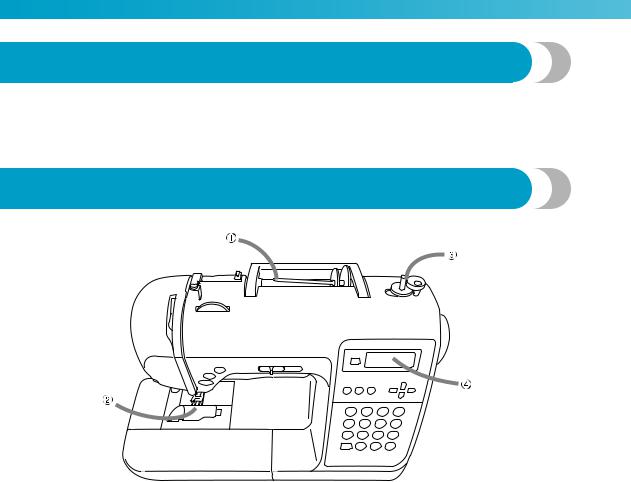
———————————————————————————————————————————————————
Introduction
Thank you for purchasing this sewing machine. Before using this sewing machine, carefully read the “Important Safety Instructions” (page 1), and then study this manual for the correct operation of the various functions. In addition, after you have finished reading this manual, store it where it can quickly be accessed for future reference.
Sewing Machine Features
aEasy upper threading
Since the spool can be installed at the front of the sewing machine, the upper thread can easily be threaded. In addition, the needle can be threaded with a simple operation (page 28).
bOne-touch lower threading
You can start sewing without pulling up the bobbin thread (page 26).
cSimple bobbin-winding
The bobbin can quickly and easily be wound with thread (page 22).
dBuilt-in stitches
You can select from the built-in stitches available, including utility stitches, character stitches and decorative stitches.
8
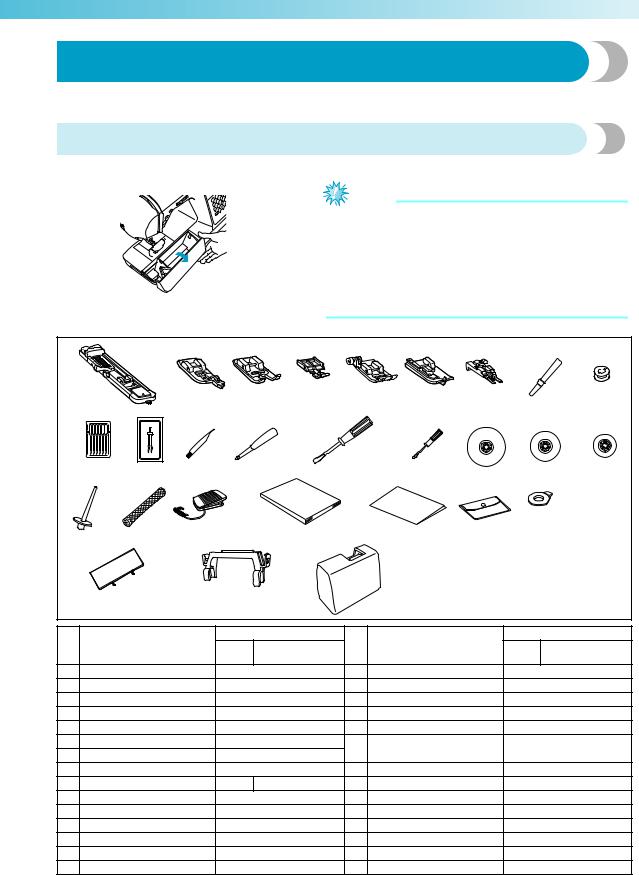
————————————————————————————————————————————————————
Accessories
After opening the box, check that the following accessories are included. If any item is missing or damaged, contact your dealer.
Included accessories
The following items should also be included in the box.
Note
(For U.S.A. only)
z Foot controller: Model T
This foot controller can be used on this machine model NS80.
z The screw for the presser foot holder is available through your authorized dealer.
(Part code: XA4813-051)
1. |
2. |
3. |
4. |
5. |
6. |
7. |
8. |
9. |
10.* |
11. |
12. |
13. |
14. |
|
15. |
16. |
17. |
18. |
19. |
20. |
21. |
22. |
|
23. |
|
24. |
25. |
|
26. |
|
27. |
|
28. |
|
* 75/11 2 needles |
|
|
|
|
|
|
|
|
|
90/14 2 needles |
|
|
|
|
|
|
|
|
|
90/14 2 needles: Ball point needle |
|||
|
|
|
|
|
|
(gold colored) |
|
|
|
No. |
Part Name |
|
|
Part Code |
No. |
Part Name |
|
Part Code |
|
|
U.S.A./ |
Others |
U.S.A./ |
Others |
|||||
|
|
|
Canada |
|
|
|
Canada |
||
|
|
|
|
|
|
|
|
||
1 |
Buttonhole foot “A” |
|
|
XC2691-033 |
16 |
Spool cap (large) |
|
|
130012-054 |
2 |
Overcasting foot “G” |
|
XC3098-031 |
17 |
Spool cap (medium) |
|
XE1372-001 |
||
3 |
Monogramming foot “N” |
|
XD0810-031 |
18 |
Spool cap (small) |
|
|
130013-154 |
|
4 |
Zipper foot “I” |
|
|
X59370-021 |
19 |
Extra spool pin |
|
|
XE2241-001 |
5 |
Zigzag foot “J” (on machine) |
|
XC3021-051 |
20 |
Spool net |
|
|
XA5523-020 |
|
6 |
Blind stitch foot “R” |
|
|
X56409-051 |
21 |
Foot controller |
|
XD0501-021 (EU area) |
|
7 |
Button fitting foot “M” |
|
130489-001 |
|
XC8816-021 (other areas) |
||||
|
|
|
|
||||||
8 |
Seam ripper |
|
|
X54243-051 |
22 |
Operation manual |
|
|
XE2408-001 |
9 |
Bobbin (4) |
|
SA156 |
SFB (XA5539-151) |
23 |
Quick reference guide |
|
XE2416-001 |
|
10 |
Needle set |
|
|
X58358-021 |
24 |
Accessory bag |
|
|
XC4487-021 |
11 |
Twin needle |
|
|
X59296-121 |
25 |
Disc-shaped screwdriver |
|
XC1074-051 |
|
12 |
Cleaning brush |
|
|
X59476-021 |
26 |
Stitch pattern plate |
|
|
XE2441-001 |
13 |
Eyelet punch |
|
|
135793-001 |
27 |
Stitch pattern plate holder |
|
XE2238-001 |
|
14 |
Screwdriver (large) |
|
|
XC8349-051 |
28 |
Hard case |
|
|
XE2446-001 |
15 |
Screwdriver (small) |
|
|
X55648-051 |
|
|
|
|
|
Accessories 9
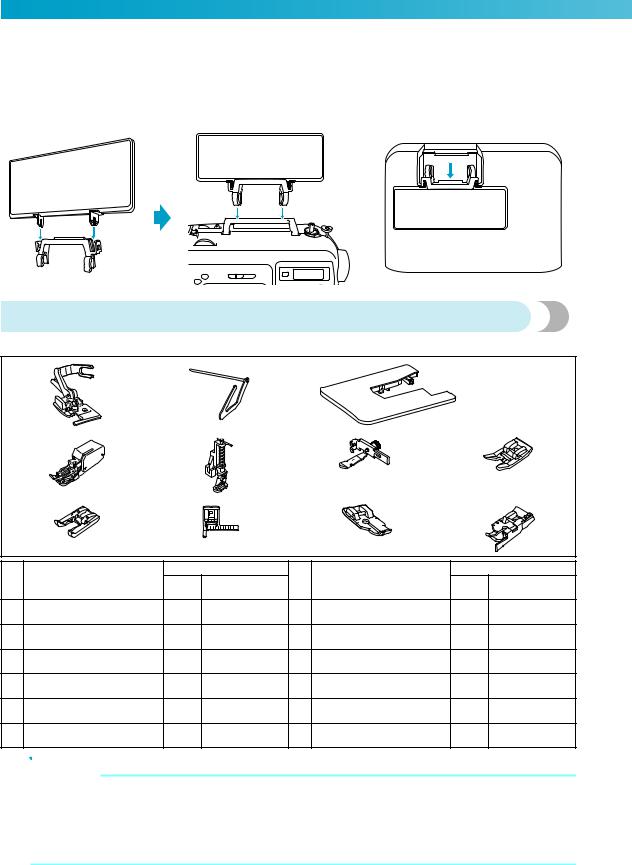
———————————————————————————————————————————————————
■Attaching the stitch pattern plate
The stitch pattern plate shows the stitches and the stitch numbers. A letter (A, G, J, N or R) indicating the presser foot that should be used appears below the stitch number. Attach the stitch pattern plate to the stitch pattern plate holder, and then attach the holder to the handle of the sewing machine as shown in the illustration below.
Optional accessories
The following are available as optional accessories.
1. |
2. |
3. |
4. |
5. |
|
|
6. |
|
7. |
|
8. |
9. |
|
|
10. |
|
11. |
|
No. |
Part Name |
|
Part Code |
No. |
Part Name |
|
Part Code |
U.S.A./ |
Others |
U.S.A./ |
Others |
||||
|
|
Canada |
|
|
Canada |
||
|
|
|
|
|
|
||
1 |
Side cutter |
SA177 |
F054 |
7 |
Non stick foot |
SA114 |
F007N |
|
|
|
(XC3879-002) |
|
|
|
(XC1949-002) |
2 |
Quilting guide |
SA132 |
F016N |
8 |
Open toe foot |
SA147 |
F027N |
|
|
|
(XC2215-002) |
|
|
|
(XC1964-002) |
3 |
Wide table |
SA552 |
WT8 |
9 Stitch guide foot “P” |
SA160 |
F035N |
|
(XE2472-001) |
(XC1969-002) |
||||||
4 |
Walking foot |
SA140 |
F033N |
10 1/4 inch quilting foot |
SA125 |
F001N |
|
(XC2214-002) |
(XC1944-052) |
||||||
5 |
Quilting foot |
SA129 |
F005N |
11 |
1/4 inch quilting foot with |
SA185 |
F057 |
|
|
|
(XC1948-002) |
|
guide |
|
(XC7416-252) |
6 |
Adjustable zipper/piping foot |
SA161 |
F036N |
|
|
|
|
|
|
|
(XC1970-002) |
|
|
|
|
 Memo
Memo
zTo obtain optional accessories or parts, contact the nearest authorized dealership.
zAll specifications are correct at the time of printing. The part codes are subject to change without notice.
zVisit your Brother dealer for a complete listing of optional accessories available for your machine.
10
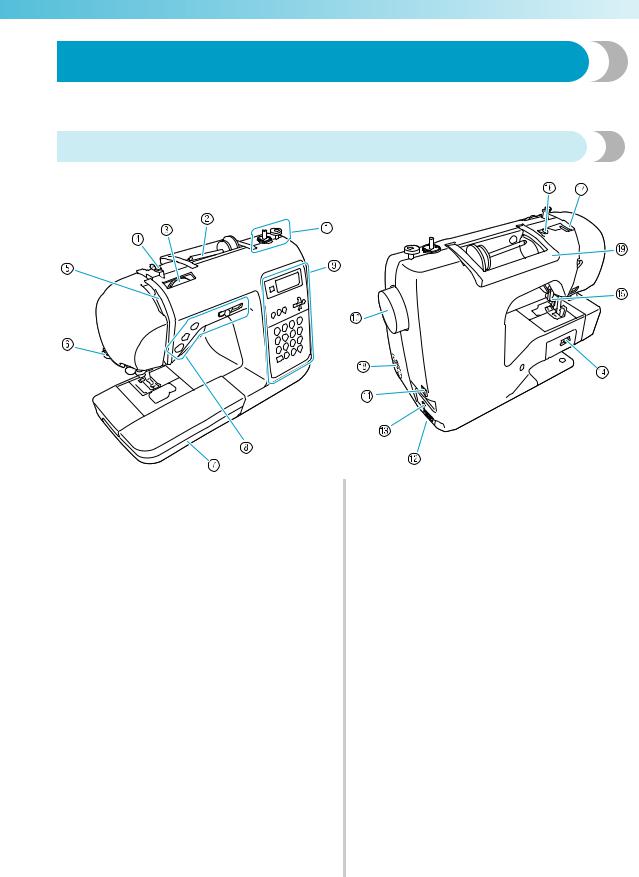
————————————————————————————————————————————————————
Names of Machine Parts and Their Functions
The names of the various parts of the sewing machine and their functions are described below. Before using the sewing machine, carefully read these descriptions to learn the names of the machine parts.
Machine
aBobbin winder (page 22)
Use the bobbin winder when winding the bobbin.
bSpool pin (page 22, 28)
Place a spool of thread on the spool pin.
cThread tension dial (page 57)
Use the thread tension dial to adjust the tension of the upper thread.
dBobbin-winding thread guide and pretension disk (page 22)
Pass the thread around this thread guide and around the pretension disk when winding the bobbin thread.
eThread take-up lever (page 30)
Slide the thread into the thread take-up lever from the right side of slot to the left side of slot.
fThread cutter (page 56)
Pass the threads through the thread cutter to cut them.
gFlatbed attachment (page 46)
Store presser feet and bobbins in the flatbed attachment. Remove the flatbed attachment when sewing cylindrical pieces such as sleeve cuffs.
hOperation buttons (page 12)
Use these buttons and the slider to start the sewing machine and raise and lower the needle.
iOperation panel (page 13)
Use to select stitches and various other stitch settings.
jHandwheel
Turn the handwheel toward you to sew one stitch or to raise or lower the needle.
kMain power switch (page 17)
Use this switch to turn the sewing machine on and off.
lPower supply jack (page 17)
Insert the plug on the power cord into the power supply jack.
mFoot controller jack (page 52)
Insert the plug on the end of the foot controller cable into the foot controller jack.
nFeed dog position switch (page 85)
Use this switch to lower the feed dogs.
oPresser foot lever (page 28)
Raise and lower this lever to raise and lower the presser foot.
pThread guide (page 24)
Pass the thread under this thread guide when winding the bobbin thread and threading the machine.
qThread guide cover (page 24)
Pass the thread under this thread guide when winding the bobbin thread and threading the machine.
rAir vent
This vent allows the air surrounding the motor to circulate.
sHandle
Carry the sewing machine by its handle when transporting the machine.
Names of Machine Parts and Their Functions 11
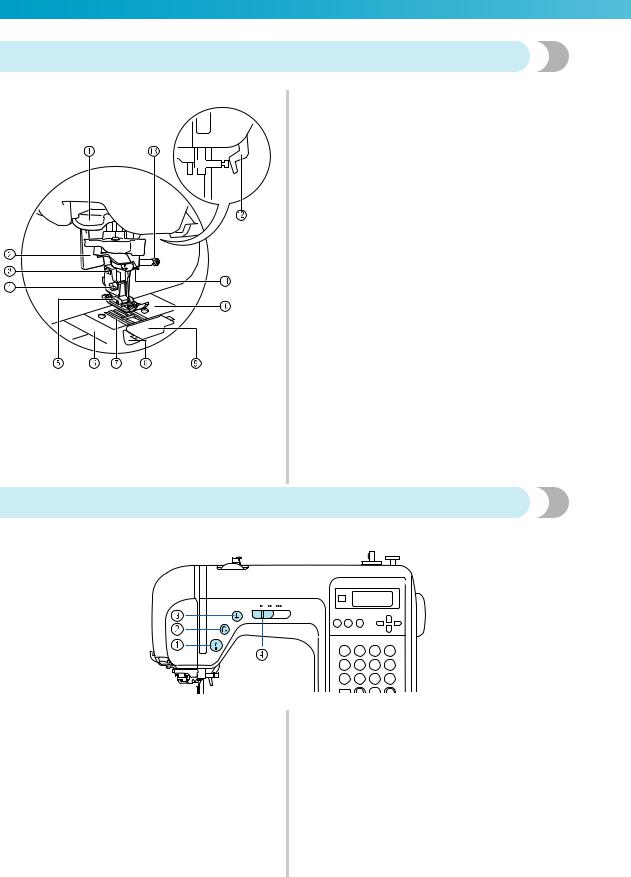
———————————————————————————————————————————————————
Needle and presser foot section
aNeedle threader lever
Use the needle threader to thread the needle.
bButtonhole lever
Lower the buttonhole lever when sewing buttonholes and bar tacks.
cPresser foot holder
The presser foot is attached to the presser foot holder.
dPresser foot holder screw
Use the presser foot holder screw to hold the presser foot in place.
ePresser foot
The presser foot applies pressure to the fabric during sewing. Attach the appropriate presser foot for the selected stitch.
fNeedle plate cover
Remove the needle plate cover to clean the bobbin case and race.
gFeed dogs
The feed dogs feed the fabric.
hQuick lower threader
Begin sewing without pulling up the bobbin thread.
iBobbin cover/race
Remove the bobbin cover to insert the bobbin into the race.
jNeedle plate
The needle plate is marked with guides to help sew straight seams.
kNeedle bar thread guide
Pass the upper thread through the needle bar thread guide.
lPresser foot lever
Raise and lower this lever to raise and lower the presser foot.
mNeedle clamp screw
Use the needle clamp screw to hold the needle in place.
Operation buttons
The operation buttons help you to easily perform various basic sewing machine operations.
aStart/stop button 
Press the start/stop button to start or stop sewing. The machine sews at a low speed at the beginning of sewing while the button is continuously pressed. When sewing is stopped, the needle is lowered into the fabric. For details, refer to “Starting to sew” (page 52).
bReverse/reinforcement stitch button 
Press the reverse/reinforcement stitch button to sew reverse stitches or reinforcement stitches. Reverse stitches are sewn by keeping the button pressed down to sew in the opposite direction. Reinforcement stitches are sewn by sewing 3 to 5 stitches on top of each other. For details, refer to “Securing the stitching” (page 54).
cNeedle position button 
Press the needle position button to raise or lower the needle. Pressing the button twice sews one stitch.
dSewing speed controller
Slide the sewing speed controller to the left or right to adjust the sewing speed.
Slide the sewing speed controller to the left to reduce the sewing speed, or slide the speed controller to the right to increase the sewing speed.
12
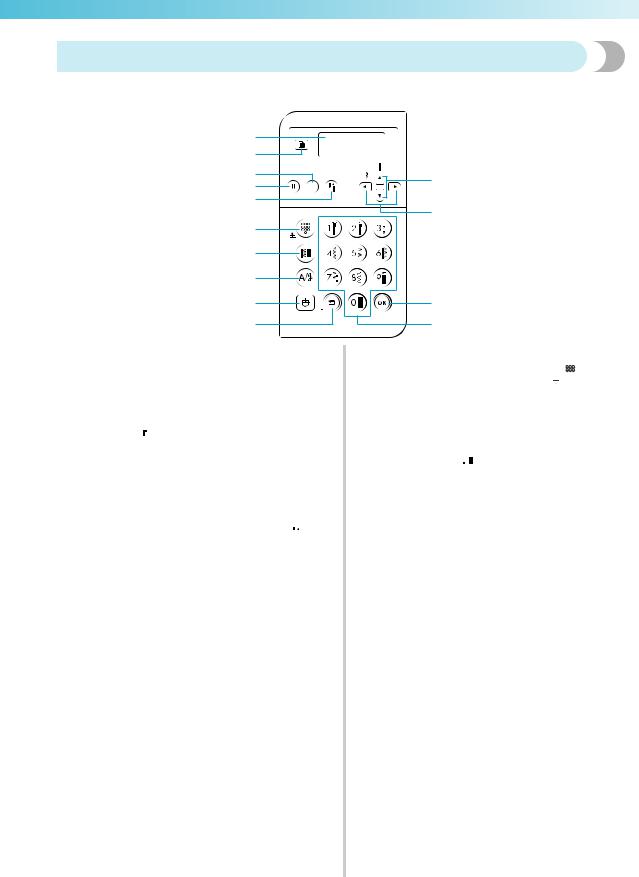
————————————————————————————————————————————————————
Operation panel
The operation panel, located on the front at the right of the sewing machine, consists of the LCD (liquid crystal display) and keys for specifying various sewing settings.
1
2
3
5
4
8
9
@
A
C
aLCD (liquid crystal display)
Settings for the selected stitch and error messages for incorrect operations appear in the LCD. Use keys b and f through n, described below, to display various items and select the settings. For details, refer to “Understanding the LCD Screens” (page 18).
bSettings key 
Press this key to select sewing settings, such as for left/ right mirror imaging, or other settings such as the operation beep.
cNeedle position key 
Press this key to raise or lower the needle.
dAutomatic reverse/reinforcement stitch key 
Press this key to select the automatic reverse/ reinforcement stitching setting. Press this key again to cancel the setting.
eNeedle mode selection key (single/twin) 
Press this key to select the twin needle sewing setting. Each time this key is pressed, the setting switches between single needle sewing and twin needle sewing.
fStitch width keys
Press  or
or  to adjust the stitch width setting.
to adjust the stitch width setting.
gStitch length keys
Press  or
or  to adjust the stitch length setting.
to adjust the stitch length setting.
7
6
B
D
■ Stitch mode keys (h-j)
hPreset utility stitch/saved pattern key 

Press this key to select the utility stitch assigned to a numeric key or to retrieve a pattern that has been saved. Each time this key is pressed, the machine switches between the preset utility stitch mode and the saved pattern mode.
iUtility stitch key 
Press this key to select a straight stitch, zigzag stitch, buttonhole, blind hem stitch, decorative stitch, satin stitch, or cross-stitch. Use the numeric keys to type in the number of the desired stitch.
jCharacter/utility decorative stitch key 
Press this key to select character stitch mode or utility decorative stitch mode, where patterns can be combined. Each time this key is pressed, the machine switches between utility decorative stitch mode and character stitch mode.
kMemory key 
Press this key to save stitch patterns, such as combined patterns, in the sewing machine's memory.
lOK key 
Press this key to apply the selection or perform the operation.
mCancel/clear key 
Press this key to cancel the operation and return to the previous screen.
In addition, pressing this key removes the last pattern added when combining characters or decorative stitches.
nNumeric keys
Use these keys to quickly select one of the ten most often used stitches. When selecting other stitches, use these keys to type in the number of the desired stitch.
Names of Machine Parts and Their Functions 13

———————————————————————————————————————————————————
14
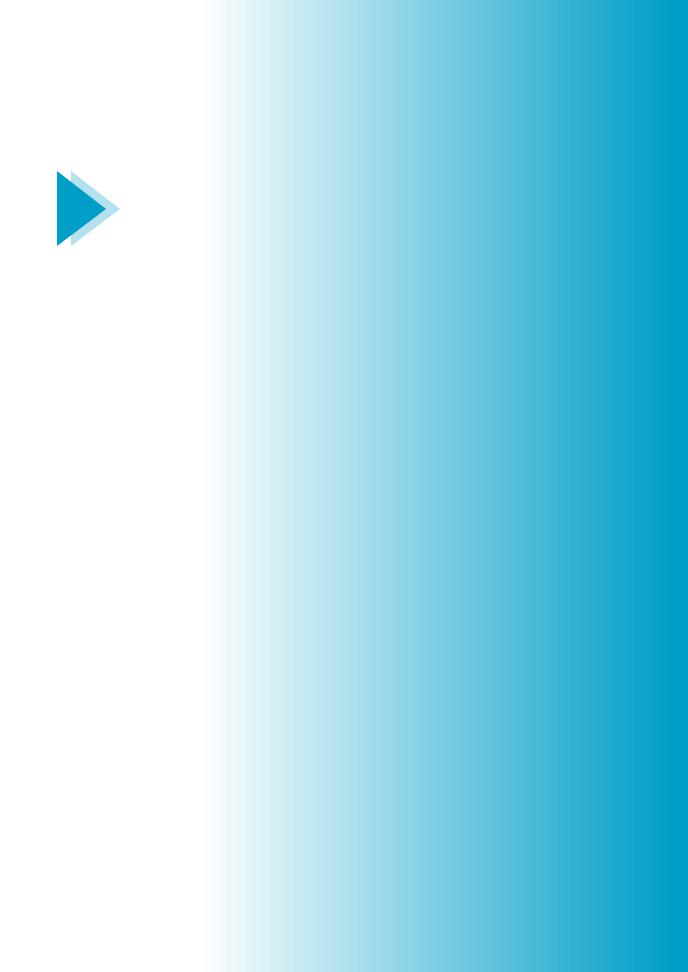
1 GETTING READY
The various preparations required before starting to sew are described in this chapter.
Turning the Machine On/Off .................................................................................. |
16 |
Power supply precautions .................................................................................. |
16 |
Turning on the machine ..................................................................................... |
17 |
Turning off the machine ..................................................................................... |
17 |
Understanding the LCD Screens.............................................................................. |
18 |
Changing the Machine Settings ............................................................................... |
19 |
Changing the settings ......................................................................................... |
19 |
Adjusting the brightness of the LCD................................................................... |
21 |
Winding/Installing the Bobbin................................................................................. |
22 |
Bobbin precautions ............................................................................................ |
22 |
Winding the bobbin ........................................................................................... |
22 |
Installing the bobbin .......................................................................................... |
26 |
Upper Threading ..................................................................................................... |
28 |
Threading the upper thread................................................................................ |
28 |
Threading the needle.......................................................................................... |
31 |
Threading the needle manually (without using the needle threader).................. |
33 |
Using the twin needle ........................................................................................ |
33 |
Pulling up the bobbin thread.............................................................................. |
36 |
Replacing the Needle .............................................................................................. |
37 |
Needle precautions ............................................................................................ |
37 |
Needle types and their uses................................................................................ |
38 |
Checking the needle........................................................................................... |
39 |
Replacing the needle .......................................................................................... |
39 |
Replacing the Presser Foot ...................................................................................... |
41 |
Presser foot precautions..................................................................................... |
41 |
Replacing the presser foot.................................................................................. |
41 |
Removing the presser foot holder ...................................................................... |
43 |
Using the optional walking foot ......................................................................... |
44 |
Sewing Cylindrical or Large Pieces.......................................................................... |
46 |
Stitching cylindrical pieces................................................................................. |
46 |
Sewing large pieces of fabric.............................................................................. |
46 |

GETTING READY ————————————————————————————————————————————
Turning the Machine On/Off
This section explains how to turn the sewing machine on and off.
Power supply precautions
Be sure to observe the following precautions concerning the power supply.
 WARNING
WARNING
●Use only regular household electricity for the power source. Using other power sources may result in fire, electric shock, or damage to the machine.
●Make sure that the plugs on the power cord are firmly inserted into the electrical outlet and the power supply jack on the machine.
●Do not insert the plug on the power cord into an electrical outlet that is in poor condition.
●Turn off the main power and remove the plug in the following circumstances:
•When you are away from the machine
•After using the machine
•When the power fails during use
•When the machine does not operate correctly due to a bad connection or a disconnection
•During electrical storms
 CAUTION
CAUTION
●Use only the power cord included with this machine.
●Do not use extension cords or multi-plug adapters with many other appliances plugged in to them. Fire or electric shock may result.
●Do not touch the plug with wet hands. Electric shock may result.
●When unplugging the machine, always turn off the main power first. Always grasp the plug to remove it from the outlet. Pulling on the cord may damage the cord, or lead to fire or electric shock.
●Do not allow the power cord to be cut, damaged, modified, forcefully bent, pulled, twisted, or bundled. Do not place heavy objects on the cord. Do not subject the cord to heat. These things may damage the cord and cause fire or electric shock. If the cord or plug is damaged, take the machine to your authorized dealer for repairs before continuing use.
●Unplug the power cord if the machine is not to be used for a long period of time. Otherwise a fire may result.
16
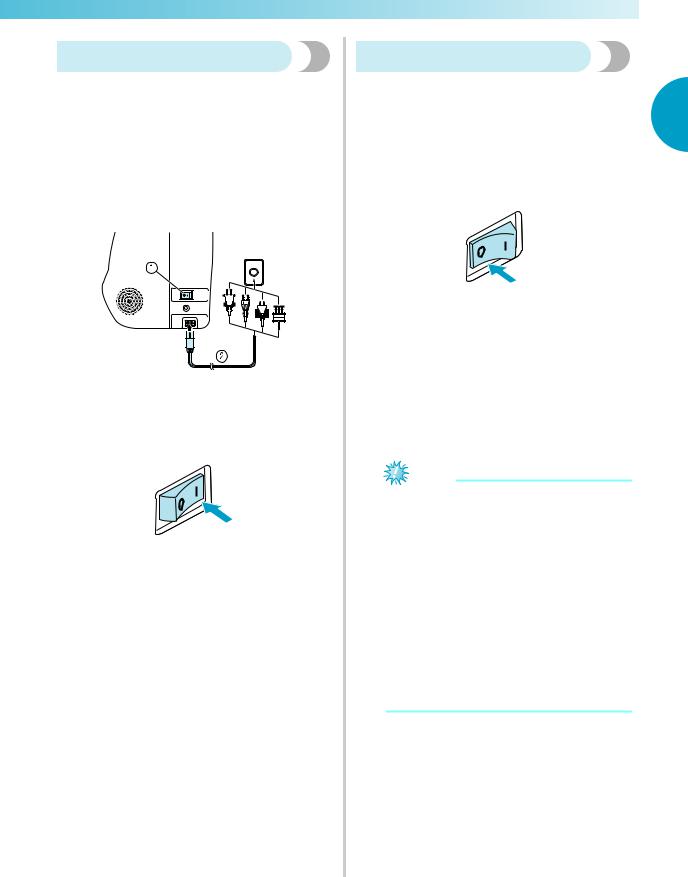
————————————————————————————————————————————————————
Turning on the machine
Prepare the included power cord.
aMake sure that the sewing machine is turned off (the main power switch is set to “ ”), and then plug the power cord into the power supply jack on the right side of the machine.
”), and then plug the power cord into the power supply jack on the right side of the machine.
bInsert the plug of the power cord into a household electrical outlet.
aMain power switch
bPower cord
cPress the right side of the main power switch on the right side of the machine (set it to “|”).
XThe sewing lamp and the LCD come on when the machine is turned on.
Turning off the machine
When you are finished using the sewing machine, |
|
turn it off. In addition, before transporting the sewing |
1 |
machine to another location, be sure to turn it off. |
aMake sure that the machine is not sewing.
bPress the left side of the main power switch on the right side of the machine (set it to “ ”).
”).
XThe sewing lamp and the LCD go off when the machine is turned off.
cUnplugoutlet. the power cord from the electrical
Grasp the plug when unplugging the power cord.
dUnplugjack. the power cord from the power supply
Note
zIf a power outage occurs while the sewing machine is being operated, turn off the sewing machine and unplug the power cord. When restarting the sewing machine, follow the necessary procedure to correctly operate the machine.
(For U.S.A. only)
zThis appliance has a polarized plug (one blade wider than the other). To reduce the risk of electrical shock, this plug is intended to fit in a polarized outlet only one way. If the plug does not fit fully in the outlet, reverse the plug. If it still does not fit, contact a qualified electrician to install the proper outlet. Do not modify the plug in any way.
Turning the Machine On/Off 17
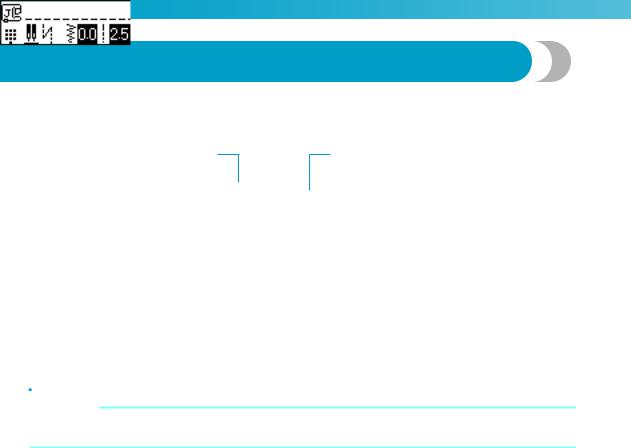
GETTING READY ————————————————————————————————————————————
Understanding the LCD Screens
The LCD screen, located on the front at the right of the sewing machine, displays the settings for the selected stitch and error messages if operations are performed incorrectly. The LCD displays the following information.
15
2 |
|
|
|
|
|
|
6 |
|
|
|
|
|
|
||
3 4 |
|
|
7 |
||||
|
|
||||||
aPresser foot that should be used
bStitch mode
cTwin needle/needle stop position
dAutomatic reverse/reinforcement stitches
eSelected stitch
fStitch length (mm)
gStitch width (mm)
 Memo
Memo
zFor details on the error messages that appear when an operation is performed incorrectly, refer to “Error messages” (page 132).
18
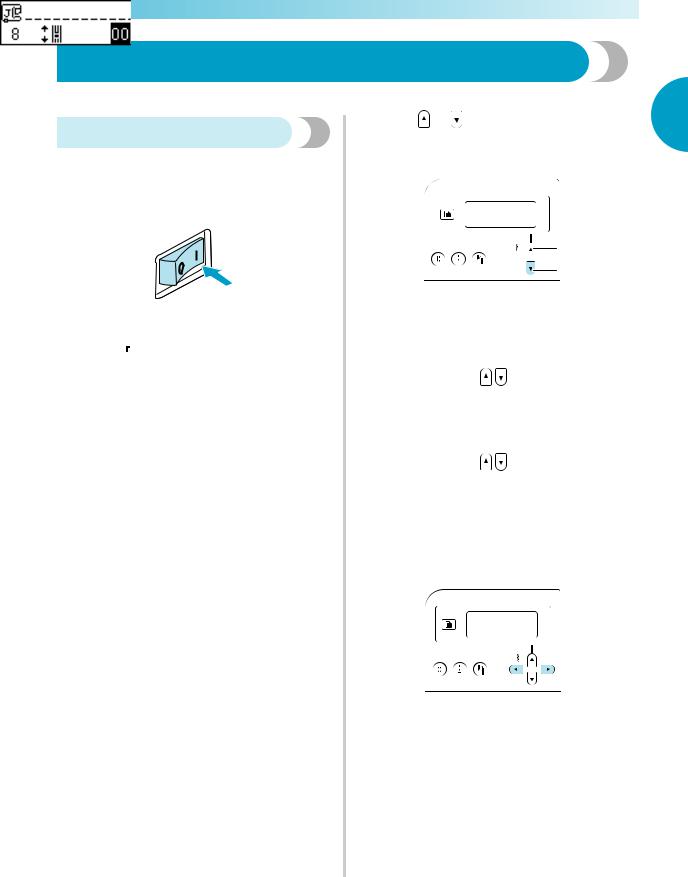
————————————————————————————————————————————————————
Changing the Machine Settings
Various sewing machine operations and sewing settings can be changed.
Changing the settings
The general procedure for changing machine settings is described below.
aTurn on the sewing machine.
X The LCD comes on.
bPresspanel. (Settings key) in the operation
(Settings key) in the operation
X The settings screen appears.
Press |
or |
(Stitch length keys) until the |
1 |
cstitch or machine attribute that you wish to set |
|
||
is displayed.

 1
1
a Stitch length keys
dPress  or
or  (Stitch width keys) until the desired setting is selected.
(Stitch width keys) until the desired setting is selected.
X The setting is changed.
ePresskey).  (OK key) or
(OK key) or  (Cancel/clear
(Cancel/clear
X The initial stitch screen appears again.
Changing the Machine Settings 19
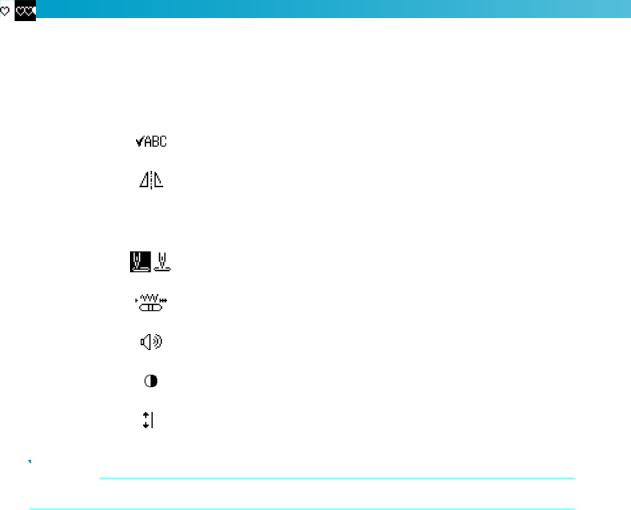
GETTING READY ————————————————————————————————————————————
■List of stitch or machine attributes
The stitch or machine attributes that can be set are listed below. For details on each attribute, refer to the corresponding reference page.
Attribute |
Icon |
Details |
Reference |
|
|
|
|
Check pattern |
|
Allows combined patterns to be checked. |
page 112 |
|
|
|
|
Mirror imaging |
|
Mirror images patterns along a vertical axis. |
page 113 |
|
|
|
|
Repeated/ |
|
Specifies whether the pattern will be sewn once or |
page 112 |
single sewing |
|
repeatedly. |
|
|
|
||
|
|
|
|
Initial needle |
|
Select the straight stitch that is automatically selected |
- |
position |
|
when the machine is turned on. |
|
|
|
||
|
|
|
|
Stitch width |
|
Allows the stitch width to be adjusted with the sewing |
page 98 |
control |
|
speed controller. |
|
|
|
||
|
|
|
|
Buzzer |
|
Specifies whether or not a beep is sounded with each |
page 134 |
|
operation. |
||
|
|
|
|
|
|
|
|
LCD brightness |
|
Adjusts the brightness of the LCD. |
page 21 |
|
|
|
|
Vertical pattern |
|
Adjusts the up and down position of the pattern. |
page 116 |
adjustment |
|
||
|
|
|
|
|
|
|
|
 Memo
Memo
z The icon shown highlighted above is the default setting.
20
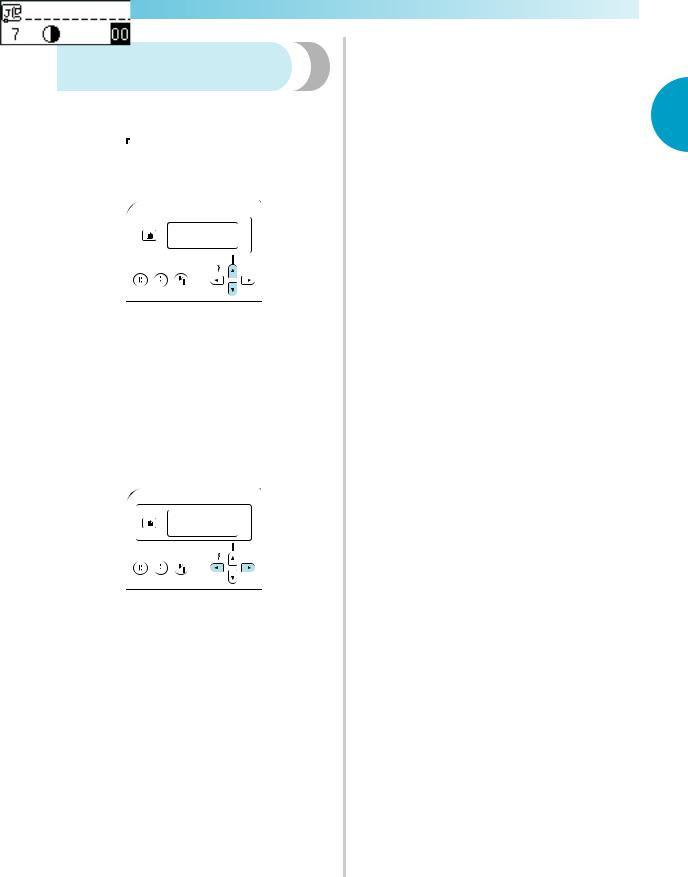
————————————————————————————————————————————————————
Adjusting the brightness of the LCD
The brightness of the LCD can be adjusted. |
1 |
|
aPress  (Settings key) in the operation panel, and then press
(Settings key) in the operation panel, and then press  or
or  (Stitch length keys) until
(Stitch length keys) until  is displayed.
is displayed.
XThe screen for changing the brightness of the LCD appears.
bTo make the LCD brighter, press  (Stitch width key). To make the LCD darker, press
(Stitch width key). To make the LCD darker, press  (Stitch width key).
(Stitch width key).
X The brightness of the LCD is changed.
cPresskey).  (OK key) or
(OK key) or  (Cancel/clear
(Cancel/clear
X The initial stitch screen appears again.
Changing the Machine Settings 21
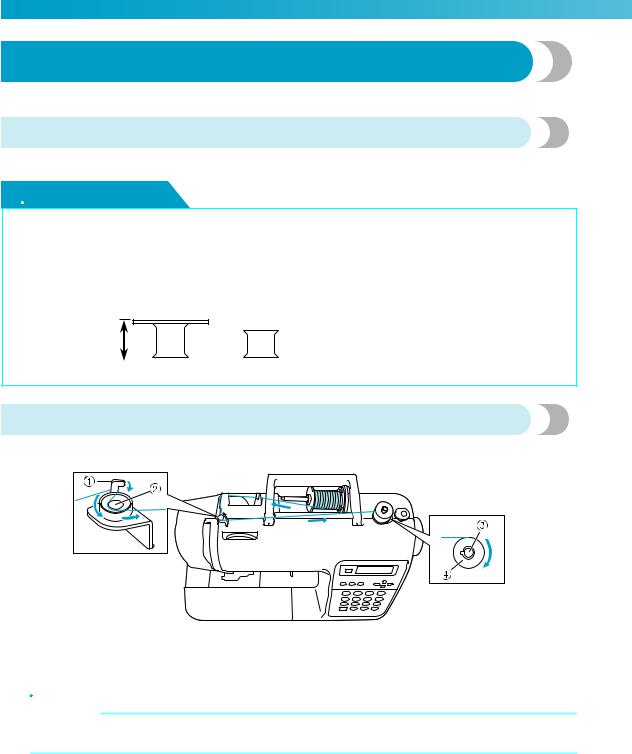
GETTING READY ————————————————————————————————————————————
Winding/Installing the Bobbin
This section describes how to wind the thread onto the bobbin, and then insert the bobbin thread.
Bobbin precautions
Be sure to observe the following precautions concerning the bobbin.
 CAUTION
CAUTION
●Only use the bobbin (part code: SA156, SFB(XA5539-151)) designed specifically for this sewing machine. Use of any other bobbin may result in injuries or damage to the machine.
●The included bobbin was designed specifically for this sewing machine. If bobbins from other models are used, the machine will not operate correctly. Use only the included bobbin or bobbins of the same type (part code: SA156, SFB(XA5539-151)).
1 |
|
|
|
a |
Actual size |
|
|
|
|
b |
This model |
4 |
|
|
|
|
|
|
|
|
|
c Other model |
|
|
|
|
|
|
|
|
|
d 11.5 mm (7/16 inch) |
|
|
|
|
|
|
|
|
|
|
|
|
|
|
|
|
|
|
|
|
|
|
|
23
Winding the bobbin
Wind the thread around the bobbin to prepare the bobbin thread.
a
aHook of the bobbin-winding thread guide
bPretension disk
cBobbin winder shaft
dBobbin
 Memo
Memo
zThe order that the machine should be threaded for winding the bobbin is indicated by a broken line on the sewing machine. Be sure to thread the machine as indicated.
22
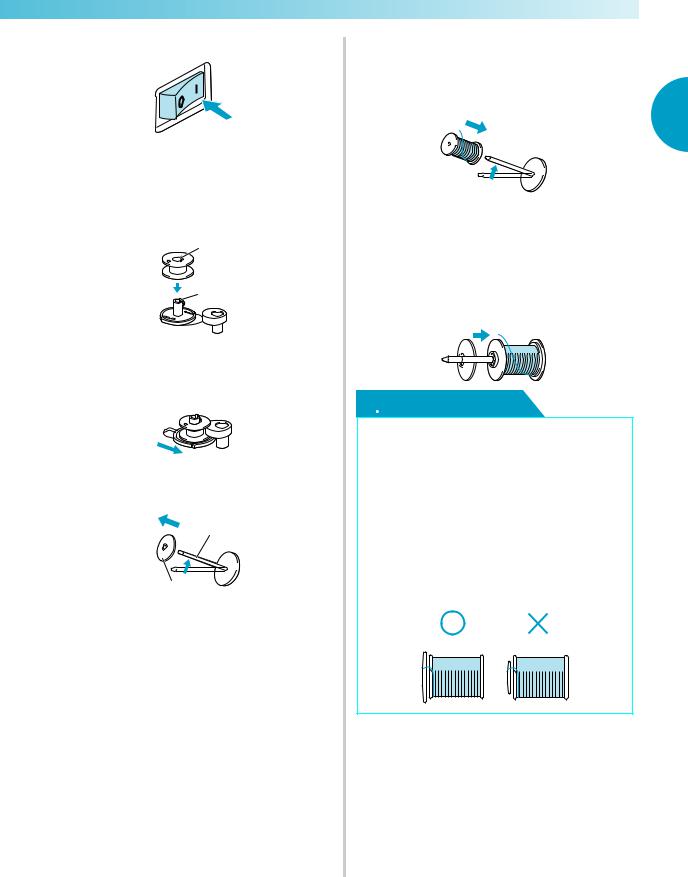
————————————————————————————————————————————————————
aTurn on the sewing machine.
bPlace the bobbin on the bobbin winder shaft so that the spring on the shaft fits into the notch in the bobbin.
Press down on the bobbin until it snaps into place.
a
b
aNotch
bBobbin winder shaft spring
cSlide the bobbin winder shaft to the right until it snaps into place.
dRemovespool pin.the spool cap that is inserted onto the
a
b
aSpool pin
bSpool cap
ePlace the spool of thread for the bobbin onto the spool pin.
Slide the spool onto the pin so that the spool is horizontal and the thread unwinds to the front
at the bottom.
1
•If the spool is not positioned so that the thread unwinds correctly, the thread may become tangled around the spool pin.
fSlide the spool cap onto the spool pin.
Slide the spool cap as far as possible to the right, as shown, with the rounded side on the left.
 CAUTION
CAUTION
●If the spool or the spool cap is not positioned correctly, the thread may become tangled around the spool pin and the needle may break.
●Three spool cap sizes are available (large, medium and small), allowing you to choose a spool cap that best fits the size of spool being used. If the spool cap is too small for the spool being used, the thread may catch on the slit in the spool and the needle may break.
Winding/Installing the Bobbin 23

GETTING READY ————————————————————————————————————————————
 Memo
Memo
zWhen sewing with fine, cross-wound thread, use the small spool cap, and leave a small space between the cap and the spool.
c b
a
aSpool cap (small)
bSpool (cross-wound thread)
cSpace
z When using thread that winds off quickly, such as transparent nylon thread or metallic thread, place the spool net over the spool before placing the spool of thread onto the spool pin.
If the spool net is too long, fold it to fit the size of the spool.
When the spool net is used, the tension of the upper thread will slightly increase. Be sure to check the thread tension. For details, refer to “Adjusting the Thread Tension” (page 57).
1 2
3

4
aSpool net
bSpool
cSpool cap
dSpool pin
gWhile holding the spool with your right hand, pull the thread with your left hand, and then pass the thread under the thread guide.
hPass the thread under the thread guide cover from the back to the front.
Hold the thread with your right hand so that there is no slack in the thread that is pulled out, and then pass the thread under the thread guide cover with your left hand.
a
a Thread guide cover
iPull the thread to the right, pass it under the hook of the bobbin-winding thread guide, and then wind the thread counterclockwise between the discs, pulling it in as far as possible.
aHook of the bobbin-winding thread guide
bPretension disk
Note
zMake sure that the thread passes under the pretension disk.
jWhile using your left hand to hold the thread that was passed through the bobbin-winding thread guide, use your right hand to wind the end of the thread clockwise around the bobbin five or six times.
 1
1

a Thread guide
24
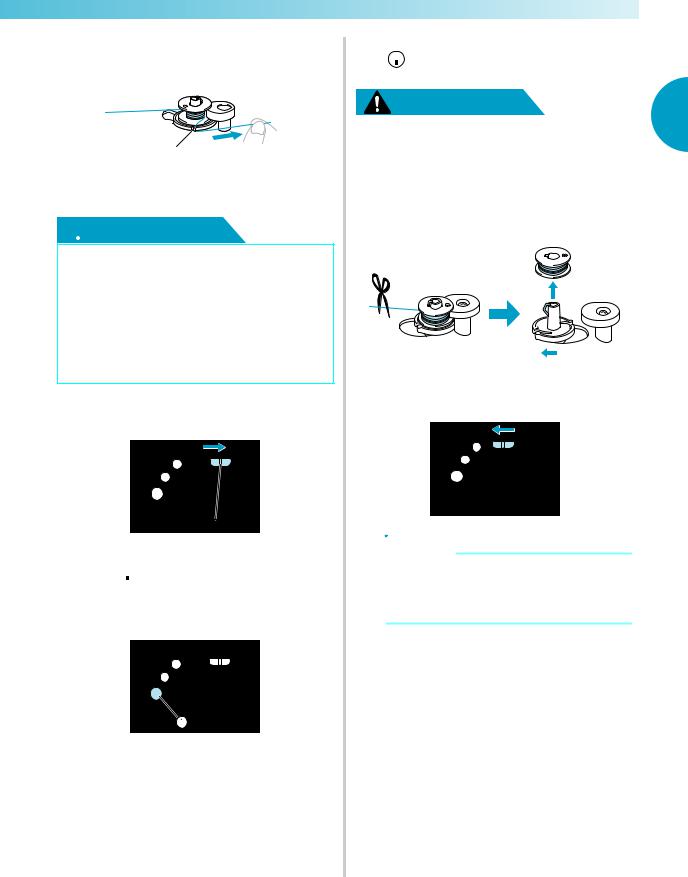
————————————————————————————————————————————————————
kPass the end of the thread through the slit in the bobbin winder seat, and then pull the thread to the right to cut it.
a
a Slit in bobbin winder seat (with built-in cutter)
X The thread is cut to a suitable length.
 CAUTION
CAUTION
●Be sure to cut the thread as described. If the bobbin is wound without cutting the thread using the cutter built into the slit in the bobbin winder seat, the bobbin may not be wound correctly. In addition, the thread may become tangled in the bobbin or the needle may bend or break when the bobbin thread starts to run out.
lSlide the sewing speed controller to the right
(for a faster sewing speed).
a Sewing speed controller
mPress  (start/stop button) once.
(start/stop button) once.
XThe bobbin starts spinning and the thread is wound around the bobbin.
nWhen the bobbin winding becomes slow, press
 (start/stop button) once to stop the machine.
(start/stop button) once to stop the machine.
CAUTION |
1 |
|
● When the bobbin winding becomes slow, |
||
|
||
stop the machine, otherwise the sewing |
|
|
machine may be damaged. |
|
|
|
|
oCut the thread, slide the bobbin winder shaft to the left, and then remove the bobbin from the shaft.
pSlide the sewing speed controller back to its original position.
 Memo
Memo
zWhen the sewing machine is started or the handwheel is turned after winding the bobbin, the machine will make a clicking sound; this is not a malfunction.
a start/stop button
Winding/Installing the Bobbin 25
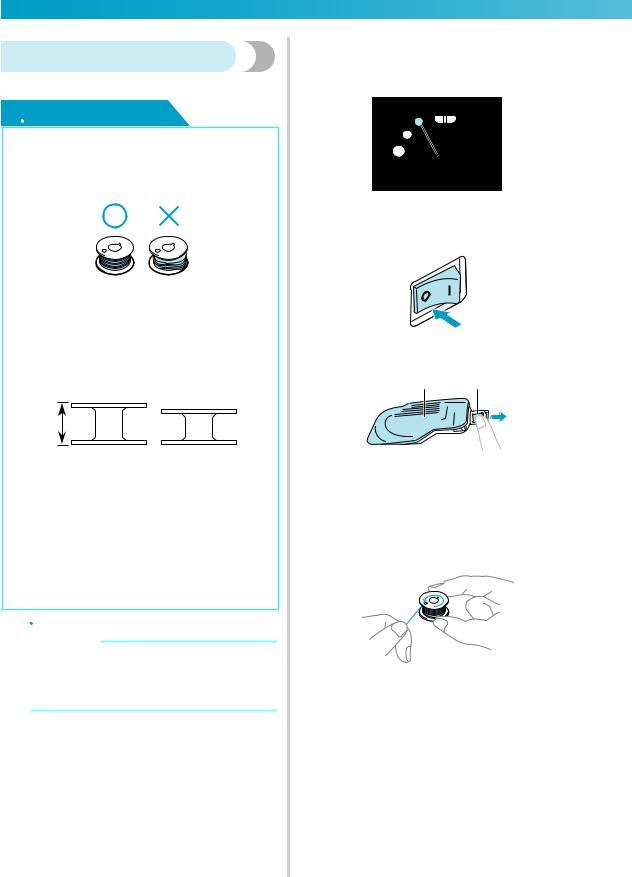
GETTING READY ————————————————————————————————————————————
Installing the bobbin
Install the bobbin wound with thread.
 CAUTION
CAUTION
●Use a bobbin that has been correctly wound with thread, otherwise the needle may break or the thread tension will be incorrect.
●The bobbin was designed specifically for this sewing machine. If bobbins from other models are used, the machine will not operate correctly. Use only the included bobbin or bobbins of the same type (part code: SA156, SFB(XA5539-151)).
1
4
23
aActual size
bThis model
cOther model
d11.5 mm (7/16 inch)
●Before installing the bobbin or replacing the needle, be sure to turn off the sewing machine, otherwise injuries may occur if start/stop button is accidentally pressed and the machine starts sewing.
 Memo
Memo
zThe order that the bobbin thread should be passed through the bobbin case is indicated by marks around the bobbin case. Be sure to thread the machine as indicated.
aPress  (needle position button) once or twice to raise the needle, and then raise the presser foot lever.
(needle position button) once or twice to raise the needle, and then raise the presser foot lever.
a Needle position button
bTurn off the sewing machine.
cSlide the bobbin cover latch to the right. a b
aBobbin cover
bLatch
X The bobbin cover opens.
dRemove the bobbin cover.
eHold the bobbin with your right hand and hold the end of the thread with your left.
• Be careful not to drop the bobbin.
26
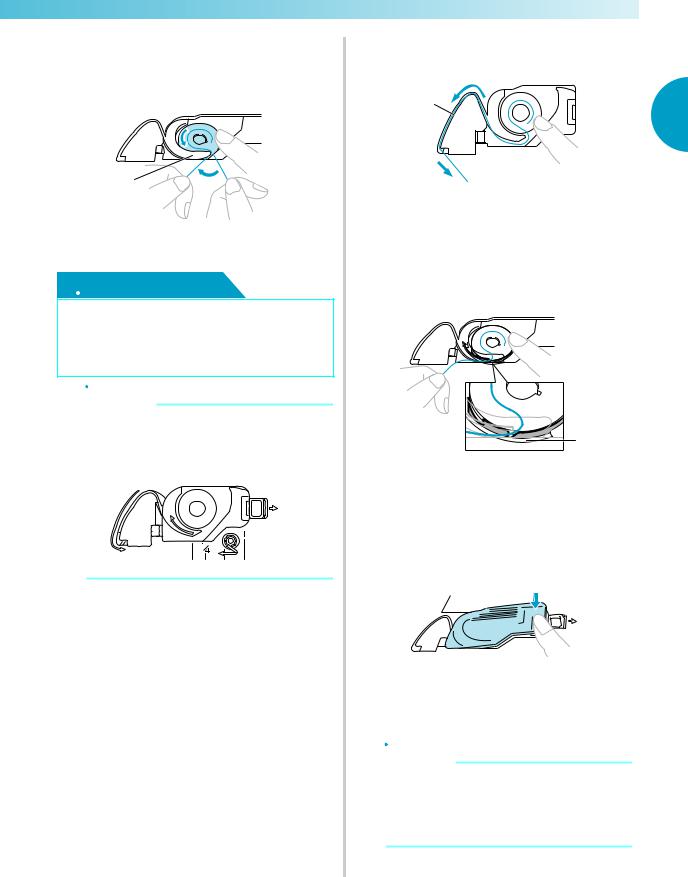
————————————————————————————————————————————————————
fInsert the bobbin with your right hand so that the thread unwinds to the left side, and then pull the thread firmly under the tab with your left hand.
a
a Tab
• Be sure to insert the bobbin correctly.
 CAUTION
CAUTION
●Be sure to install the bobbin so that the thread unwinds in the correct direction, otherwise the thread may break or the thread tension will be incorrect.
 Memo
Memo
zThe order that the bobbin thread should be passed through the bobbin case is indicated by marks around the bobbin case. Be sure to thread the machine as indicated.
gGuide the thread through the slot, and then pull it toward you to cut it with the cutter.
a
1
b

aSlot
bCutter
X The cutter cuts the thread.
•Make sure that the thread is correctly passed through the flat spring of the bobbin case. If it is not inserted correctly, reinstall the thread.
a
a Flat spring
hReattach the bobbin cover.
Insert the tab in the lower-left corner of the bobbin cover (A), and then lightly press down on the right side (B).
B
 A
A
X The lower threading is finished.
Next, thread the upper thread. Continue with the procedure in “Upper Threading” (page 28).
 Memo
Memo
zYou can begin sewing without pulling up the bobbin thread. If you wish to pull up the bobbin thread before starting to sew, pull up the thread according to the procedure in “Pulling up the bobbin thread” (page 36).
Winding/Installing the Bobbin 27

GETTING READY ————————————————————————————————————————————
Upper Threading
In this section, the procedures for positioning the spool for the upper thread and threading the needle are described.
a Spool pin
b Mark on handwheel
 CAUTION
CAUTION
●When threading the upper thread, carefully follow the instructions. If the upper threading is not correct, the thread may become tangled and the needle may bend or break.
●The needle threader can be used with sewing machine needles 75/11 through 100/16.
●Use appropriate thread and needle combinations. For details on appropriate needle and thread combinations, refer to “Needle types and their uses” (page 38).
●Thread with a thickness of 130/20 or thicker cannot be used with the needle threader.
●The needle threader cannot be used with the wing needle or the twin needle.
●If the needle threader cannot be used, refer to “Threading the needle manually (without using the needle threader)” (page 33).
 Memo
Memo
zThe order that the machine should be threaded is indicated by a solid line on the sewing machine. Be sure to thread the machine as indicated.
Threading the upper thread
Set the spool of thread on the spool pin, and then thread the machine.
aTurn on the sewing machine.
bRaise the presser foot lever.
a Presser foot lever
 CAUTION
CAUTION
●If the presser foot is not raised, the sewing machine cannot be threaded.
28
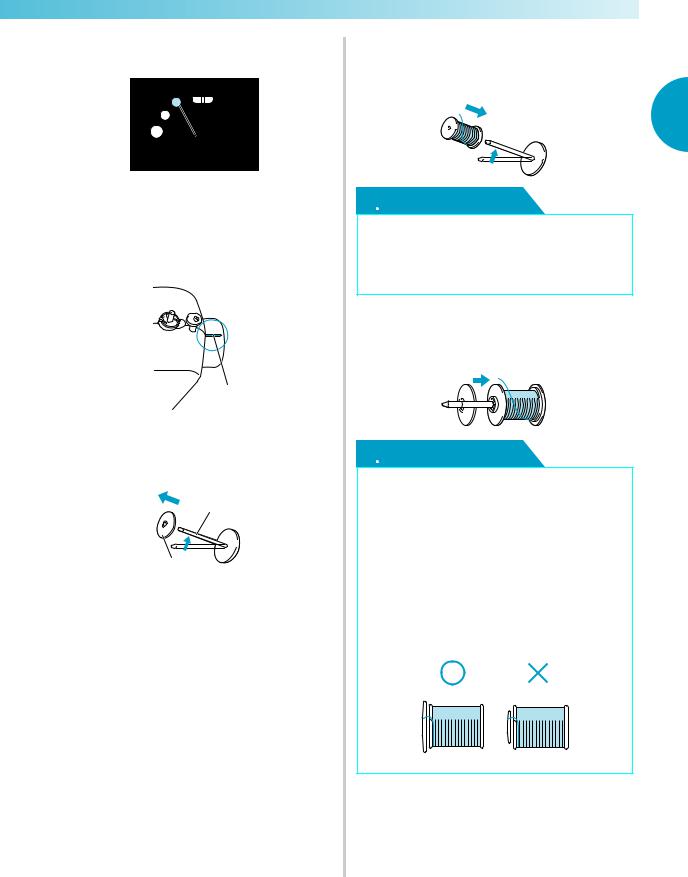
————————————————————————————————————————————————————
cPress  (needle position button) once or twice to raise the needle.
(needle position button) once or twice to raise the needle.
a Needle position button
XThe needle is at the correct height when the mark on the handwheel is at the top, as
shown below. Check the handwheel and, if
this mark is not at this position, press  (needle position button) until it is.
(needle position button) until it is.
a
a Mark on handwheel
dRemovespool pin.the spool cap that is inserted onto the
a
b
aSpool pin
bSpool cap
ePlace the spool of thread onto the spool pin.
Slide the spool onto the pin so that the spool is horizontal and the thread unwinds to the front at the bottom.
1
 CAUTION
CAUTION
●If the spool or the spool cap is not positioned correctly, the thread may become tangled around the spool pin and the needle may break.
fSlide the spool cap onto the spool pin.
Slide the spool cap as far as possible to the right, as shown, with the rounded side on the left.
 CAUTION
CAUTION
●If the spool or the spool cap is not positioned correctly, the thread may become tangled around the spool pin and the needle may break.
●Three spool cap sizes are available (large, medium and small), allowing you to choose a spool cap that best fits the size of spool being used. If the spool cap is too small for the spool being used, the thread may catch on the slit in the spool and the needle may break.
Upper Threading 29
